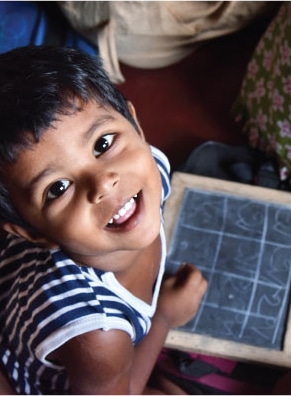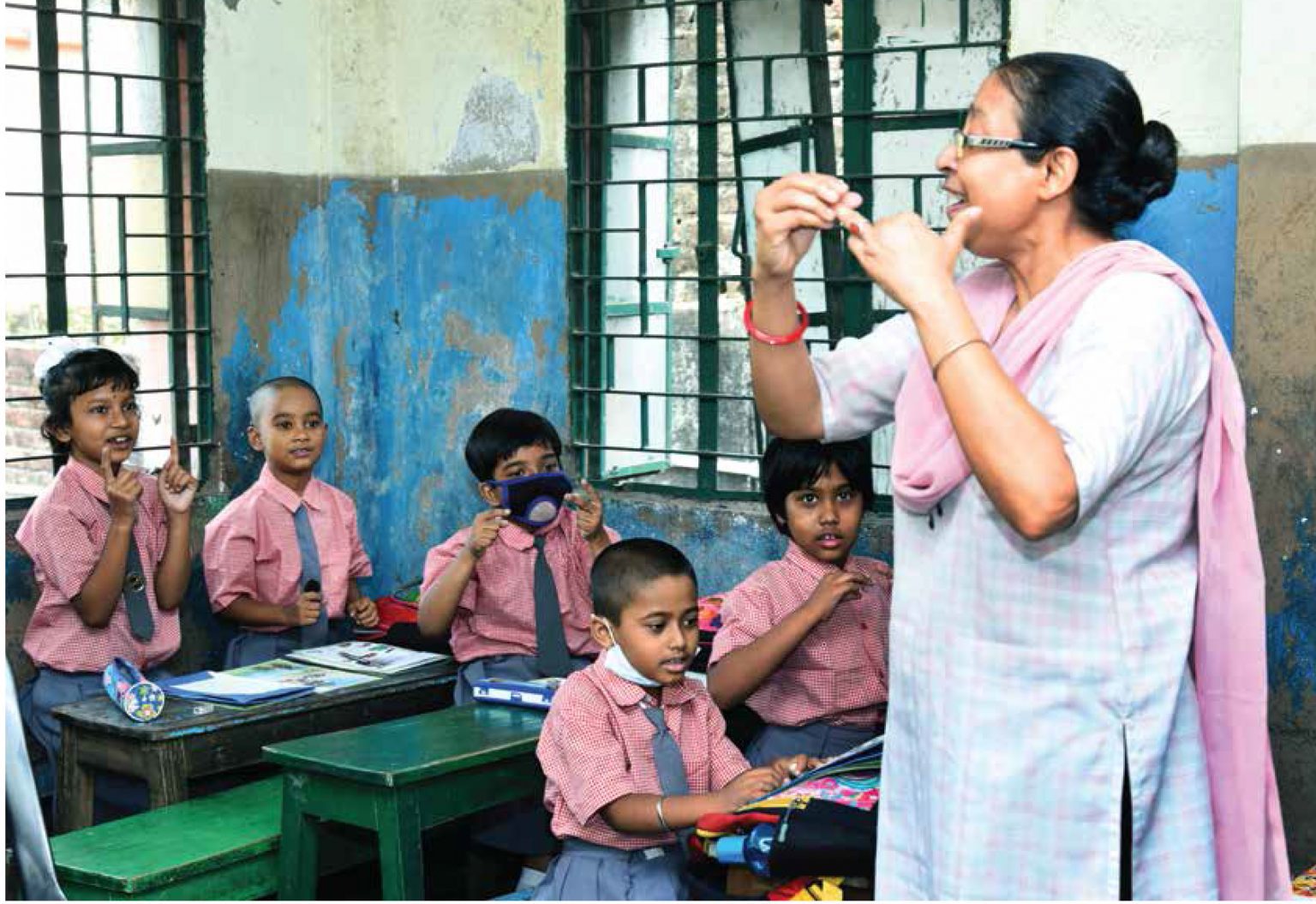November 2022

Afroz (name changed) works as a domestic help in the apartment complexes of Noida, Uttar Pradesh, and stays in a rented accommodation in an urban village of the city. Many years back, in search of a livelihood, she had migrated from Bhagalpur in Bihar to the National Capital Region along with her husband. The city did not disappoint her and she was happy that she no longer had to mill rice on dhenki (a traditional rice mill made of wood and iron), which was her routine work in the village. But within a few months of staying in NCR she realised that to better the living condition of her family, she will have to work. “My neighbour worked as a domestic help and often brought home sweets and gifts. I thought why shouldn’t I? My husband was reluctant but I convinced him,” says Afroz.
As per the Unified District Information System for Education (UDISE+) Report 2020-21, in 2019-20, only 5.5 lakh schools in the country had functional computers.
Afroz has three children who study in a private school now and also attend private tuitions after school. She and her husband work very hard to pay their fees. Ask her why she ls not sending her children to a government school where education is free, and she says, “Sarkari school mei achhi padhai nahin hoti. Didi soti rehti ha i. Aaj kal sab ghar meAngrezl bolne lage haln. Kai ko log apne bachon kaa khayal rakhne ke liye Angrezi bolne waali kaamwali dhundenge. Kamsekam mere bachon ko kaam to mil jayega (They do not teach well in government schools. With the
English-speaking population increasing in the country, there will be a time when people will look for educated English-speaking maids and caretakers. My children will at least get that job).” Afroz has hlg h aspirations for her chlldren but Is very practical in her approach.
When the Right of Children to Free and compulsory Education (RTE) Act, 2009, came Into effect in April 2010, it incited hope that India’s public education system would be strengthened if it is ensured that no child in the country is deprived of education. The government reports looked fair till the pandemic forced the closure of schools and learning shifted to an online medium where a computer or a smart phone and internet connection became requirements for parents If learning of their children had to be continued. Many children across the country were deprived of elementary and se<:ondary education not only because their parents could not afford it but also because many schools lagged behind in basic technical infrastructure.
As per the Unified District I nformatlon System for
Education (UDISE+) Report 2020-21, in 2019-20, only 5.5 lakh schools in the country had functional computers. It increased to 6 lakh in 2020-21. Likewise, only3.36 lakh schools had internet facilities in 2019-20 which went up to 3.7 lakh in 2020· ZI with 40 per cent of the schools having functional computers. However, the Cross Enrollment Ratio improved and the total students enrolled ln school education from primary to higher secondary stood at 25.38 crore.
If the UDISE+ report is to be believed, 39.7 lakh children studying government-aided private schools shifted to government schools du ring the 2020-ZI academic year. Enrollment in private schools dropped at the pre-primary and primary levels by 22. 28 lakh and 11.6 la kh respectlvely while enrollment in government schools saw a rise of 18.82 lakh and 9.28 lakh in the primary and upper primary classes respectively. The reason was obvious -job loss, death of parentA, or a family member, salary cut. or loss in business increased the financial vulnerability of parents and guardians during the pandemic.

The government report stated that admission of young children in schools during the pandemic was postponed and it was noticed more among vulnerable kids llke chlldren at pre-primary, class 1 level, and Children With Special Needs (CWSN). Even as the scare of a fourth COVID-19 wave still looms, private schools that were stalled by the government from hiking the fees for the last two years, have declared an increase in tuition fees leaving parents still coping with the pandemic-induced stress, baffled.
Article 21 (A) inserted in the Indian Constitution through the 86th Constitutional Amendment Act made free and compulsory education of all chlldren In the age group of 06-14 years, a Fundamental Right. The National Education Policy (N EP) 2020 which came up after a gap of 34 years and is aligned to the Sustainable Development Coal (SDO) 4 of ensuring Inclusive and equitable qua llty education and promoting lifelong learning opportunities for a II, also emphasizes guaranteeing un iversa I access to school education at a II levels. Over the years, the school enrollment rate has increased in the country but dropout has not stopped completely. The annual dropout rate of secondary school students in 2020-21 was recorded at 14.6 per cent.
To bring back children who have dropped out from school and to prevent further dropping out of children from school, the NEP 2020 stresses providing effective and sufficient infrastructure so that all students have access to safe and engaging school education at all levels from pre-primary school to Crade 12.
In alignment with SDCi 4, some states have taken infrastructure development in schools seriously. Delhi has al ready set an example. In Odisha, as of now, the makeO\l’er is limited to high schools as it is primarily funded by the school alumni under the Mo School Abhiyan. An all-inclusive change in the education ecology is being brought about by states like
Rajasthan, Hlmachal Pradesh,Jharkhand, and Andhra Pradesh. Kerala has always been way ahead of others but even Harya na is making inroads to make 80 per cent of government school students in elementary classes saksham (grade competent) through the state’s flagship programme Saksham Haryana.
Education which was once a State subject was shifted to the Concurrent List by the 42nd Constitutional Amendment Act. Though the Centre has powers to bring uniform educational reforms, the responsibility lies with the states to ensure proper implementation of the laws and policies. be it RTE or NEP. It would not be very fair to compare the outcome of one state with the other given that the economy and ecology of states differ, but an effort to Improve the quality of education wll I have to be attempted by all the states. There is mushrooming growth of private schools and hardly any efforts made by state governments to establlsh new government schools or monitor the quality of education in private schools.
Afroz says, »Mai to anpadh hoon. Mere shauhar pad he likhe ha in, lekin Angrezi mei achhe nahin haln. Upar se ye project wagalra, hamare paas kahan time hai (I can’t read and write. My husband can, but he is not good at English. And do we have time for school projects).” But she finds it strange when her employers send their wards to the
so-called top schools of the city and also struggle to help with their children’s project work A good curriculum, advanced educational learning materials and chic infrastructure cannot ensure quality learning. schools, both government and private, will have to be trained in engaging children, unearthing their hidden talents, boosting their self-esteem, preparing them for life, and showing them the way forward.
The N EP 2020 also reiterates that education is a public service and access to quality education must be considered a basic right of every child”. What we need ls a strong, vibrant public education system. Charities in India supported by responsible individuals and corporate are doing their bit in reaching out to disadvantaged children. The number of appllca nts for Kendrlya Vldyalayas across the country is proof that if quality education is provided in State-owned schools, it would be the first choice of not only the disadvantaged groups but also of the Indian middle class. Nevertheless much more needs to be done to make universal access to high-quality education, a reality in the true sense.
Swami Vivekananda, the great Indian Philosopher’s words of wisdom should inspire us to do much more for our children,
“We want the education by which character is formed,
strength of mind is increased, the intellect is expanded,
and by which one can stand on one’s own feet.”




